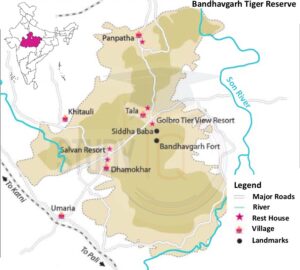Table of Contents
Bandhavgarh Tiger Reserve
Bandhavgarh Tiger Reserve is located in the Umaria district of Madhya Pradesh state in India. It covers an area of about 105 square kilometers and is situated in the Vindhya Hills of the Umaria district.
According to the 2018 tiger census, the reserve is home to about 90 tigers, making it one of the top Tiger Reserves in India in terms of tiger population. Apart from tigers, the reserve is also home to several other species of animals such as leopards, sloth bears, wild dogs, and several species of deer and antelope. In the past, the reserve has also been home to a few white tigers. White tigers are not a separate subspecies of a tiger but are a genetic variant of the Bengal Tiger. They are extremely rare in the wild and are only found in certain parts of India. In the past, white tigers were often hunted for their beautiful white fur, which is caused by a rare genetic mutation.
Read More: Bandipur National Park
Bandhavgarh Tiger Reserve History
Bandhavgarh Tiger Reserve was declared a national park in 1968 and later in 1993, it was declared a tiger reserve under the Project Tiger initiative. The reserve is also known for its beautiful landscapes and ancient temples, which attract tourists from all over the world. The best time to visit the reserve is between November and June when the weather is pleasant and the chances of spotting tigers are high.
Read More: Nagarhole National Park
Bandhavgarh Tiger Reserve Map
Here is a map of the Bandhavgarh Tiger Reserve given below for a better understanding:

Bandhavgarh Tiger Reserve Landscape
Bandhavgarh Tiger Reserve is situated in the Vindhya Range of mountains, which is a relatively low mountain range in central India. The reserve is located at an altitude ranging from 440 meters to 810 meters above sea level. The landscape of the reserve is characterized by undulating hills and plateaus, with several streams and rivers cutting through the terrain.
The reserve is surrounded by several hills and mountains, which add to its scenic beauty. Some of the notable hills in the reserve include Bandhavgarh Hill, Bamera Hill, and Shesh Shaiya Hill. Bandhavgarh Hill is the highest point in the reserve, with an elevation of 810 meters above sea level. The hill is also home to the Bandhavgarh Fort, which is a popular tourist attraction in the reserve.
The reserve is also crisscrossed by several small rivers and streams, including the Charanganga River, the Dammer River, and the Johilla River. These rivers and streams provide water to the animals in the reserve and also add to the beauty of the landscape. In addition to the rivers, the reserve also has several small ponds and waterholes that are important sources of water for the animals, especially during the dry season.
Apart from mountains, hills, and rivers, the reserve is also home to several other notable relief features, including caves, rock formations, and valleys. For example, Bhadrakali rock, which is located in the reserve, is a popular spot for rock climbing and offers stunning views of the surrounding landscape. The reserve also has several caves, including the Bandhavgarh Cave and the Baghel Museum Cave, which are popular tourist attractions.
Read about: Amrabad Tiger Reserve
Bandhavgarh Tiger Reserve Fauna
Bandhavgarh Tiger Reserve is a sanctuary for various forms of wildlife, such as mammals, birds, amphibians, and others, with several noteworthy species highlighted below.
| Fauna Category | Important Species | Details |
| Tigers | Royal Bengal Tiger | Bandhavgarh has one of the highest densities of tigers in the world with about 90 tigers as per the 2018 census. |
| Leopards | Indian Leopard | The reserve is home to a significant population of leopards, which are mostly found in the hilly and rocky areas of the reserve. |
| Sloth bears | Indian Sloth Bear | Bandhavgarh is known for its high density of sloth bears, and the reserve has been identified as one of the key sloth bear habitats in India. |
| Wild dogs | Indian Wild Dog | The reserve has a significant population of Indian wild dogs, which are also known as dholes. These animals are highly social and hunt in packs. |
| Deer and Antelope | Sambar, Spotted Deer, Barking Deer, Nilgai, Chinkara | Bandhavgarh is home to several species of deer and antelope, including the majestic Sambar and the graceful Spotted Deer. |
| Other Mammals | Indian Bison, Wild Boar, Indian Fox, Indian Hare, Porcupine | The reserve is also home to several other mammals, including Indian Bison, Wild Boar, Indian Fox, Indian Hare, and Porcupine. |
| Birds | Crested Serpent Eagle, White-Bellied Drongo, Indian Roller, Asian Paradise Flycatcher | Bandhavgarh is a birdwatcher’s paradise and is home to several species of birds, including some rare and endangered ones. |
Read about: Kanha Tiger Reserve
Bandhavgarh Tiger Reserve Flora
Bandhavgarh Tiger Reserve is a combination of dry deciduous forests and grasslands, making it a unique landscape. The following section provides a detailed account of the reserve’s flora.
| Flora Category | Important Species | Details |
| Trees | Sal, Saja, Dhobin, Tendu, Arjun | The Sal forests in Bandhavgarh Tiger Reserve are some of the most extensive and pristine Sal forests in Central India. |
| Shrubs | Bamboo, Mahua, Kadam, Ber | Bamboo is the dominant shrub species found in the reserve and provides an essential source of food and shelter for many animals. |
| Grasses | Khus, Spear Grass, Cymbopogon | The grasslands of Bandhavgarh Tiger Reserve are essential habitats for several herbivore species, including deer and antelope. |
| Medicinal Plants | Amla, Giloy, Kachnar, Kalmegh | Several medicinal plants are found in the reserve, which are used for traditional medicine by the local communities. |
| Aquatic Plants | Water Lilies, Lotus, Hydrilla | The aquatic plants in the reserve’s water bodies provide essential habitats for several aquatic animals, including fish and amphibians. |
Read about: Panna Tiger Reserve
Bandhavgarh Tiger Reserve Tourism
Bandhavgarh Tiger Reserve is a popular wildlife tourism destination in India. The best time to visit the reserve is from October to June when the weather is pleasant and the chances of spotting wildlife are high.
Tourists can expect to experience several activities at Bandhavgarh Tiger Reserve, such as jeep safaris, elephant safaris, birdwatching, and nature walks. The reserve is known for its high density of tigers, and tourists can expect to spot them along with other wildlife such as leopards, sloth bears, Indian wild dogs, and several species of deer and antelope.
The reserve also has several historical and cultural attractions such as Bandhavgarh Fort, which dates back to the 10th century and is situated atop a hill inside the reserve. The fort offers a panoramic view of the surrounding landscape and is a popular tourist attraction.
Read about: Anamalai Tiger Reserve
Bandhavgarh Tiger Reserve UPSC
Bandhavgarh Tiger Reserve is a popular topic for the UPSC Syllabus, especially in geography and environment-related papers. The exam may include questions related to the location, flora and fauna, history, and tourism of the reserve. Aspirants appearing for the UPSC exam should have a good understanding of the various aspects of Bandhavgarh Tiger Reserve and its significance in the conservation of wildlife in India. To enhance their preparation level for the UPSC exam, candidates can utilize the UPSC study materials available at StudyIQ UPSC and also take UPSC Mock Test to assess their knowledge and understanding of the topics.
Read about: Bandipur Tiger Reserve


 Purchasing Power Parity Index, How to Ca...
Purchasing Power Parity Index, How to Ca...
 Unemployment Rate in India, Current Rate...
Unemployment Rate in India, Current Rate...
 RBI Monetary Policy Committee: Repo Rate...
RBI Monetary Policy Committee: Repo Rate...

























